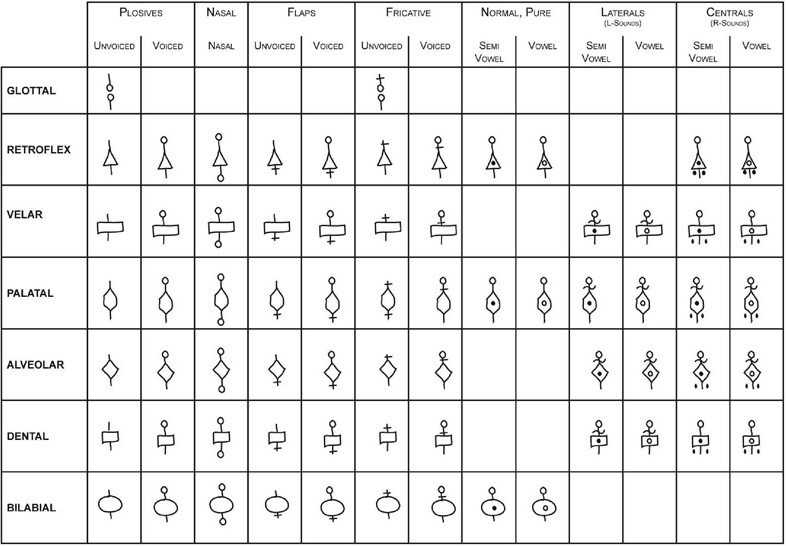The World’s First (and Only) Truly Phonemic Alphabet
More About NAVLIPI
- What are the requirements or guiding principles for a truly universal phonetic or phonemic alphabet, one that addresses all the world’s languages? How does NAVLIPI meet them?
- Exercises in attempting to invent a new alphabet using the above guiding principles.
- Comparative drawbacks of the alphabet of the International Phonetic Association (“IPA”).
- Examples of NAVLIPI post-ops (post-positional operators).
- Examples of NAVLIPI phonemic transcription: ‘phonemic condensates’.
- Example of NAVLIPI phonetic classification (2-dimensional matrix for non-vowels, more complex for vowels).
- The FULL NAVLIPI ALPHABET: “Alphabetical order” of NAVLIPI for didactic (teaching) purposes.
What are the requirements or guiding principles for a truly universal phonetic or phonemic alphabet, one that addresses all the world’s languages? How does NAVLIPI meet them?
Navlipi was designed on the following 10 guiding principles, which were thought to be the minimum requirements for a universal world script:
- Universality and completeness: Universality and the associated property, completeness, imply being able to represent, systematically and scientifically, every single phone and tone found in the world’s major languages. This is really a minimum requirement for any universal orthography. It implies that the script must above all be a universal and accurate phonetic (phonic) script.
- Recognizability: Recognizability necessarily means the use of the Roman “alphabet” (script) as a basis, since historical happenstance has rendered this particular orthography ubiquitous in all corners of the world. Thus, for instance, a highly scientific and easily keyboarded orthography based purely on geometric shapes, as presented as an exercise further below, would be useless in terms of recognizability. Lack of recognizability, and distinctiveness are two major deficiencies of the “alphabet” of the International Phonetic Association (IPA, based in London, England). For example, in the IPA, many glyphs (letters) appear to be straight from outer space! And the many very similar IPA glyphs, are highly confusing, even to the expert. Examples among these are the various inverted and rotated e’s and a’s, the inverted/rotated/hooked, etc. variants of r and R used to represent the various alveolar trills, flaps or uvular “r’s”, and the variants of n with inward/outward hooks, etc. used for the various nasals. They are also, incidentally, very difficult to transcribe cursively and to keyboard. Navlipi makes use of the Roman alphabet with very few new letters/glyphs, by, among other techniques, using redundant letters in orthographically very recognizable fashion, coupled with intuitive renditions of these. Thus, e.g.: the redundant “c” (redundant vs. “k”) is used as a vowel, from its “iconic, intuitive” resemblance to “e”, and to an open mouth. So also the redundant “q”, from its similar iconic, intuitive resemblance to “a”. The various cursive and print renditions of “r” in the Roman-script are used differently and in easily recognizable fashion to denote various, differing centrals (r-sounds). Rare fricatizations of plosives are rendered with a fricatization post-op (again derived from “h”), obviating the need for a new letter/glyph.
- Distinctiveness: Distinguishability of one letter of the script from another, especially those representing related phones. The property of distinctiveness, is closely related to recognizability. It implies that two glyphs, especially those representing similar phones, should be easily distinguishable. The IPA alphabet is especially deficient in distinctiveness.
- Simplicity and intuitive nature. Simplicity is also reflected in ease of learning. And simplicity and intuitive nature are also properties associated with recognizability: The IPA alphabet in one sense reflects the opposite of simplicity: the sheer, unmanageable number of IPA letters/glyphs and diacritics is mind-boggling. This leads to associated problems, such as slow keyboarding. Intuitive nature can be expressed in many ways. In orthography, it can be expressed by using, for example, [aa] and [a] for the open and open-mid jaw positions of the central vowel (as in English but and father respectively). Other examples of “intuitive” selections include the duplication of vowel letters to indicate vowel lengthening, e.g. short [i], [u] vs. long [ii], [uu]. This is a very simple method already used, e.g., in modern Finnish. It may be compared to the keyboard-unfriendly and difficult-to-recognize long-vowel post-op used by the IPA. Similarly, trills are simply and intuitively rendered by repetition of the flap symbol, e.g. [rr] is the trilled version of [r]. In keyboarding, simplicity and intuitive nature can be expressed by using (Ctrl+h) and (Alt+h) to keyboard the aspirate-postop [] and fricative-postop [h₀], or (Ctrl+n), (Alt+n) and (Ctrl-Shift+n) to keyboard various nasal stops.
- Ease and rapidity of transcription from three points of view: keyboard, cursive, and print. High amenability to cursive writing. Many features of Navlipi address these properties efficiently. For example, Navlipi makes very substantial use of postpositional operators (“postops” or “post-ops” for short, briefly presented above). Among these are the subscripted circle discussed above (e.g. as in pₒ, see above), and a subscripted oval. The subscripted circle is rendered in cursive as a “following-little-e”. The subscripted oval is rendered in cursive as a “small leg”. Navlipi also thoroughly addresses keyboard transcription and voice-recognition-transcription. With regard to handwriting, Navlipi assumes that writing by hand will still remain one of the main methods of language transcription. (This assumption appears unfortunately to be increasingly invalid in the 21st century!) The use of postops also facilitates keyboarding, because it means that, rather than entirely new symbols (and entirely new keys) being required for new letters, just a few postops, combined with existing letters, suffice to accommodate a huge number of new letters. (In our count in Navlipi, there are just ten distinct post-ops, of which five are very rare.) Thus, just a few additional keys assigned to these postops take the place of a slew of new keys that may be required if entirely new letters were to be used. And in actual practice, due to the use of language-specific keyboards by Navlipi, even these post-op keys are not required in most cases. Keyboard selections in Navlipi are very logical, with almost no disruption of the American QWERTY scheme, yet minimal addition of new keys. Navlipi also uses a set of very distinct, easy to write, print and keyboard postops for tones as well. This makes tones much easier to recognize and render in print, cursive and keyboard. Furthermore, the Navlipi tone postops are also extremely easy and quick to render in cursive, yet also remain very distinctive in cursive. This is in contrast to the diacritics and confusing accents used in many other transcriptions of tones, including that of the IPA. Indeed, the IPA’s rendition of tones is so difficult that many have termed reading these “decipherment” rather than reading!
- Systematic, scientific classification and accuracy. Systematic, scientific classification is unfortunately a feature lacking in the IPA, perhaps due to its ad-hoc, “build-as-you-go-along” origins. Thus, to this day, the IPA Chart unfortunately remains a rather disorganized presentation lacking meaningful form. In this respect and in contrast, Navlipi uses as a starting point the highly scientific and systematic phonological classification and arrangement of the ancient Indian scripts. (To this day, the Indian scripts, and those ultimately based on them, including the Korean Hangul (through Buddhist scriptural teaching), represent the only ab initio (from first principles) phonetic classification.) Thus, there is an inherent scientific and systematic base in Navlipi. Now this Indian phonological classification is, today, highly inadequate and incomplete, even for transcription of the Indian languages for which it is used. Nevertheless, it remains the best starting point, even today.
- Discretization. It is self-evident that most phonological variables, such as articulation position, are continuous rather than discrete variables. For example, there are innumerable positions the tongue can take that are intermediate between the alveolar and dental (or alveolar and palatal) articulation positions. Clearly, some sort of discretization of this continuity is absolutely necessary to keep any phonological classification within limits.
- Practical phonemics rather than phonics. A fundamentally phonemic system is essential for a truly universal script.Thus, e.g., while some scripts (e.g. the IPA) can be used to transcribe the intricate differences in pronunciation of two individuals speaking the same language, the objective of a phonemic script should be much broader.
- Voice-recognition compatibility and a voice-recognition software package.
- The most important requirement: Ability to address phonemic idiosyncrasy: And of course, most important of all, the ability to accommodate the phonemic idiosyncrasies of all the world’s major languages. To reiterate, no world script has achieved this, to date.
Exercises in attempting to invent a new alphabet using the above guiding principles
While the above guiding principles appear very thorough and complete, they can also lead to pitfalls if not followed meticulously and in their entirety. As an example of this, we may attempt to devise a certain type of alphabet ab initio (from first principles) which is highly scientific: One based on geometric figures, of the kind that highly advanced space aliens might use. Such an alphabet is shown in the figure below.
Let us look at the above alphabet and see how it meets our requirements and guiding principles. This alphabet is unquestionably highly scientific. It lists the articulation positions along one (the vertical) axis and the nature of the phone (“phonochromaticity” in Navlipi jargon) along the other, horizontal axis. It starts with a base geometric figure for the unvoiced plosive for each of the seven articulation positions shown (glottal through bilabial). This figure has short top and bottom vertical bar handles (“handlebars”) for convenience in attachment of modifications to the figure. For the velar unvoiced, unaspirated plosive, i.e. the k sound in English king, this figure is a simple rectangle. Then, to generate other phones in the velar articulation position, one simply adds modifications to this base figure. Thus, to generate the voiced velar plosive, i.e. the g sound of English good, one simply adds a little circle on the top handlebar. This little circle is added to generate all voiced plosives: E.g., for the dental voiced plosive, the d sound of Spanish dos, one simply adds a little circle to the top handlebar of the base figure for the dental articulations, which in this case is a square. Etc. etc.
Our alphabet then meets Requirements #(1), #(3), #(4) and especially #(6) extremely well.
Unfortunately, this alphabet is also utterly useless for use by Earthlings, for it does not meet one of the most important requirements, #(2) (recognizability). Earthlings would not be able to relate this alphabet to any of the Earth alphabets they are familiar with, and would in any case find it difficult to learn.
Comparative drawbacks of the alphabet of the International Phonetic Association (“IPA”)
The drawbacks of the alphabet of the International Phonetic Association (commonly designated the IPA alphabet or just the IPA), especially in the context of the Requirements of a universal script delineated above, can be summarized briefly as follows:
- Unrecognizability: Many glyphs (letters, symbols) are difficult for the layman, even one who has grown up with the Roman or Greek scripts (alphabets), to recognize. Some glyphs appear to be straight from outer space! Examples of some unrecognizable IPA glyphs are given in the Figure below.
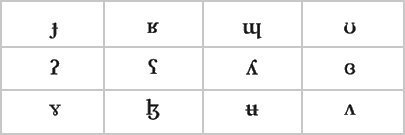
- Confusing nature of many of the letters, a property related to the unrecognizability. Many very similar glyphs, are difficult to differentiate, and are highly confusing, even to the expert. Examples among these are the various inverted and rotated e’s and a’s, the inverted/rotated/hooked, etc. variants of r and R used to represent the various alveolar trills and flaps or uvular “r’s”, and the variants of n with inward/outward hooks, etc. used for the various nasals. They are also, incidentally, very difficult to transcribe cursively and to keyboard. Examples of IPA glyphs that are confusing even for the layman for whom the Roman script is native are given in the Figure below.
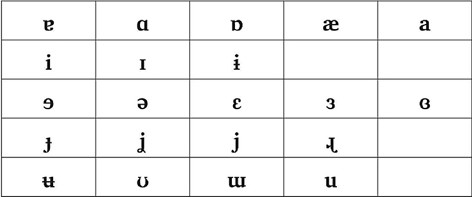
- Poor amenability to cursive writing, as the Figure below shows.
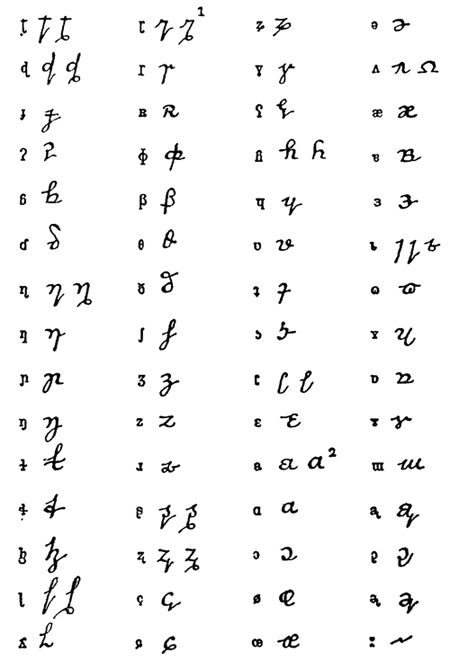
- Too many diacritics, leading to difficult manual transcription, even when not written in cursive. Manual transcription implies pen/pencil on paper. Difficulty also implies slowness. The diacritics are further compounded by too many differentiating symbols, exponents, etc. These features of the IPA are seen in the summary of IPA diacritics presented in the Figure below. In particular, the diacritics and accents used for tones, as shown below, are especially confusing.
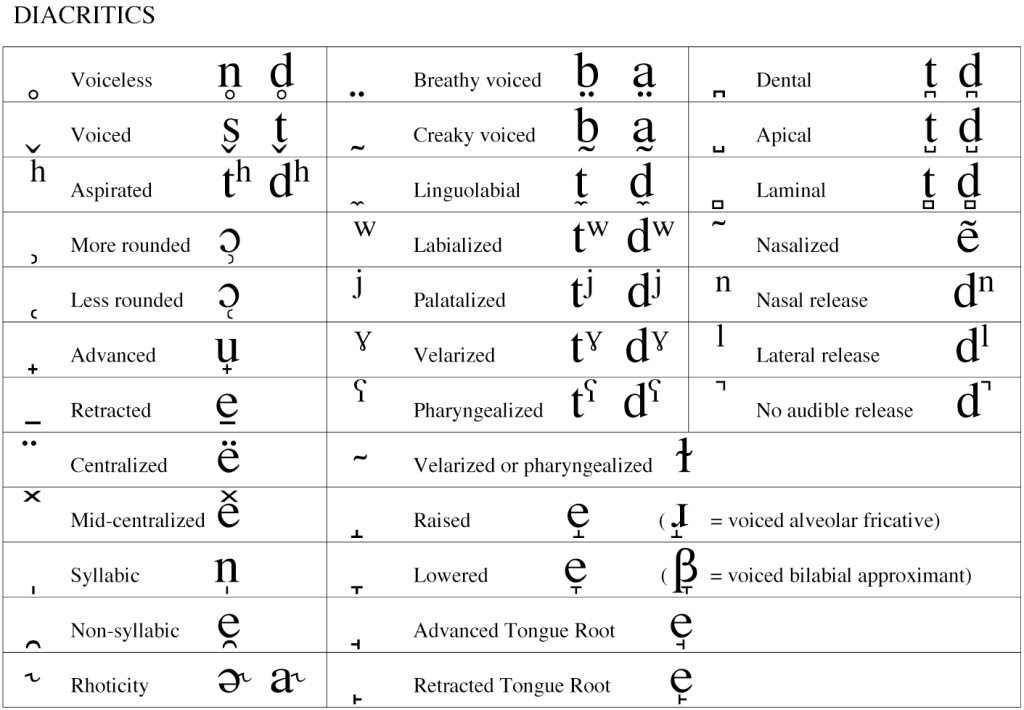
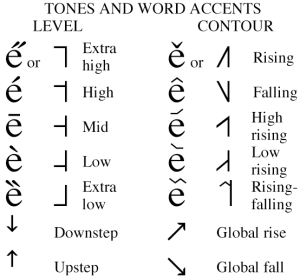
- Poor keyboarding, made even more difficult by the large number of diacritics, exponents, etc. used, and the sheer number of independent glyphs (letters). Anyone having tried transcribing a passage in the IPA using all manner of software (including embedded fonts in word processors) will readily attest to this!
- Lack of systematic organization, lack of pedagogical sense and inapplicability for everyday use: The IPA, in its various presentations (e.g. in the IPA summary chart at the beginning of its Handbook), actually ends up using, for its “consonants”, the ancient Indian system of classification: Grouping the “consonants” based on points of articulation, starting from the back (pharyngeal/-uvular/-velar) to the front (bilabial) of the oral apparatus, and then further differentiated as plosive, nasal, fricative, etc.. However, the alphabetic order retained is still that of the Roman alphabet. As a result, it is not clear from the IPA Summary Table (“IPA Chart”) what is the exact order of the letters, and how the alphabet would be learned, e.g., by schoolchildren. Does it, for example, start with [p], the very first letter at the top left of the IPA chart, and end with [inverted-a] [ɐ], the last vowel shown in the chart? The assumption of course is that it is not meant for schoolchildren, only for highly educated phoneticists and linguists!
- Incompleteness: the IPA treatment of vowels does not even consider horizontal jaw position, and only two lip positions (rounded and not rounded) are considered, these being shoehorned in to the IPA vowel charts.
- Ad-hoc, “build-as-you-go” and Eurocentric nature: These properties are transparent in the IPA, in its very nature, and in its origins in the ad-hoc Roman script. They are also evident in the way it has attempted to adapt to new languages with modifications of the same Roman letters. This has ultimately made the alphabet even more confusing and unwieldy. For example, some of the latest (2005) additions, for African languages, include new glyphs, as shown in the Figure below. This ad-hoc, build-as-you-go characteristic is due to the origins of the IPA in 19th-century Europe. An alphabet that started with a small modification of the Roman alphabet to accommodate English, French and German and then tried to gradually accommodate all the world’s languages, cannot equal, in its qualities, an alphabet or script designed ab initio, from first principles at the outset, with a knowledge of the world’s languages.
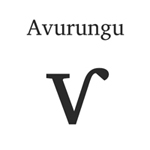
- Emphasis on “narrow transcription” rather than practical phonemics for everyday use. The IPA, in its “narrow transcription” version, is excellent for distinguishing the different pronunciation of individual speakers of the same dialect of the same language. This is no doubt a very useful property to have. However, it is of little use for practical, everyday phonemics and phonemic transcription.
- Outright errors and erroneous classification: As just some examples of these:
- The IPA designates the phones [s] and [z] as alveolar fricatives, which is entirely incorrect. The alveolar artition is made with the tip of the tongue touching the region of the alveolar ridge, whereas the [s] and [z] phones of virtually all major languages are articulated with the apico/medio portion, i.e. a bit back from the tip, of the tongue touching the alveolar ridge (or further up, closer to the dental area). The alveolar fricatives per se are quite different sounds from the [s] and [z]. The reader can verify this himself/herself, by first articulating the alveolar stop [t], as in the English t of sty, and then retaining that same artition and articulating a fricative. What ensues is something quite different from an [s]. The [s] and [z] are in fact apico/medio-dental fricatives, which is how Navlipi classifies them. That is to say, the contact is made with the apico/medio portion of the tongue, and the tip of the tongue itself is closer to the upper teeth than the alveolar ridge.
- The IPA does not treat of vocalic-[r] and vocalic-[l] at all, even though these phones are well established in languages from Sanskrit to Serbo-Croat. These phones were treated of by prominent modern phoneticists such as Lepsius, not to mention the ancient Indian phoneticists. Instead of recognizing these phones to accommodate vocalic-[r], the IPA comes up with a unique term, rhoticity, which is somewhat nebulously defined as an “[r]-flavor to a vowel”!
- The IPA then further confuses non-vocalic and vocalic phones by not recognizing a bilabial semivowel [w], but, rather, only a labiodental “approximant” (“approximant”, roughly, is the IPA term for a semivowel). Since this yields problems with the distinction of lateral and central vowels, it then distinguishes some of the lateral vowels as “lateral approximants”!
- In the treatment of both Hindi and Sindhi in its main and most popular publication, the Handbook of the International Phonetic Association, the palatal stops, of which there are four in nearly all North Indian languages (unvoiced/voiced, unaspirated/aspirated combinations), are treated as affricates. The reasons for this are not hard to find, and lie, unfortunately, in the still Eurocentric view of the IPA: Since Western European languages do not phonemically differentiate between aspirated and unaspirated stops, Western Europeans always pronounced these Indian palatal stops with aspiration, as a result of which they always came out as affricates, exactly like the identical affricates in their own languages. However, Indians articulate these clearly as stops, not affricates, and the highly adept ancient Indian phoneticists recognized them as stops (sparsha), not a combination of stops and fricatives (uushman). Strangely, though, the IPA does recognize palatal stops elsewhere, e.g. in its treatment of Irish in the very same IPA Handbook! Thus, in a sense it contradicts itself! Now anyone who has heard an Irishman’s and an Indian’s pronunciation of the palatal unvoiced stop (IPA designation [c]) will acknowledge that they are identical. One may thus speculate that the early classification of the Indian palatal stops as affricates, and not true stops, emanated from audio (spectrographic) analysis of the Indian sounds uttered into a microphone by a non-Irish European sometime in the 19th or 20th centuries!
- Another example of erroneous classification is the (incomplete) IPA treatment of vowels. For, as noted above, the IPA does not even consider the horizontal jaw position, and considers only two lip positions (rounded and not rounded), these being shoehorned in to the IPA vowel charts. In contrast, even Pike recognized many different lip and jaw positions, and Navlipi treats of two horizontal jaw positions and three lip positions. Navlipi does not consider any more lip and jaw positions for reasons of discretization and practicality.
- Sheer number of glyphs (more than 172): The IPA’s individually distinct glyphs number more than 172. One reason for this is the absence of use of such glyph-saving devices as post-ops or other indicators of phonological class, as used by Navlipi.
- Finally, the most important deficiency of all: inability to account for the phonemic idiosyncrasies of the world’s languages: This is perhaps the IPA’s most important deficiency, although, admittedly, it is also a deficiency of all scripts prior to Navlipi. This deficiency is reflected in the following examples:
- The IPA is unable to indicate to the native English speaker reading Hindi in the IPA that the unaspirated [p] and aspirated [ph] have distinct phonemic values in Hindi, whereas they have the same values in English.
- Similarly, an English speaker reading Mandarin would not be able to tell that [p] and [b] have the same value in Mandarin, or that [r] and [l] have the same value in Japanese.
- Conversely, the Arabic speaker reading English in the IPA for the very first time could not guess that the [b], the only bilabial that he/she is familiar with, has an unvoiced counterpart, [p], that has a different value than the [b].
- As another example, the IPA is unable to convey, through its orthography alone, that in Hindi, the phones [w] (bilabial semivowel) and [v] (labiodental voiced fricative) constitute part of the same phoneme and are freely interchanged.
- In a similar vein, the IPA cannot convey that, in Parisian French and “proper” German (Hochdeutsch), the phones [x] (velar unvoiced fricative), [r] [alveolar flap] and [rr] (alveolar trill) constitute part of the same phoneme and are frequently interchanged.
Examples of NAVLIPI post-ops (post-positional operators)
A few examples of NAVLIPI post-ops are given below. For a more complete list, please see Vol. I of the NAVLIPI book.
- To designate aspiration, NAVLIPI uses . This is similar to the letter h used in many Western phonetics texts, but at the same time distinguishes itself from the letter h. Thus, in NAVLIPI, p is the aspirated version of the phone p.
- For the common (aspirate + non-aspirate) phoneme, NAVLIPI simply uses a subscripted circle, ₒ. Thus the /p/ phoneme of English of the example above, which includes the phones [p] and [ph], is simply transcribed as pₒ.
- For the complex (voiced + unvoiced) phoneme present in most Chinese languages, NAVLIPI uses the post-op (a subscripted infinity sign) to indicate a combination of unvoiced (as in the p sound) and voiced (as in the b sound) phones. Thus, the bilabial Mandarin phoneme found in the word meaning “no” and pronounced both pu and bu is transcribed as b, as in bu.
- To indicate a flap, NAVLIPI simply uses a dot. Thus, in NAVLIPI, the letter
tindicates a retroflex, unaspirated plosive, andt. indicates its corresponding flap. - Similarly, to indicate an uvular or a pharyngeal variant of a sound, NAVLIPI uses a double dot. Thus, k.. indicates the pharyngeal plosive used in Arabic and frequently transliterated into Roman script with the letter q.
- To indicate a click, NAVLIPI simply uses the letter
z, i.e. the letter z with an additional crossbar or strikethrough. Thus, in NAVLIPI, a lateral click, as one would use with a horse to urge it on, is rendered lz, whereas the common dental click rendered tsk tsk in cartoon balloons in English is rendered tz.
Examples of NAVLIPI phonemic transcription: ‘phonemic condensates’
A few examples of NAVLIPI “phonemic condensates” are given below. For a more complete list, please see Vol. I of the NAVLIPI book.
-
- For less common phonemes such as the one combining the [x] (uvular fricative) and [r] (trilled “r”) in Parisian French and Hochdeutsch German, or the one combining the v and w sounds in Hindi/Urdu, NAVLIPI simply uses compound letters (glyphs), here xr and vw.
- For the complex (voiced + unvoiced) phoneme present in most Chinese languages, NAVLIPI uses the post-op (a subscripted infinity sign) to indicate a combination of unvoiced (as in the p sound) and voiced (as in the b sound) phones. Thus, the bilabial Mandarin phoneme found in the word meaning “no” and pronounced both pu and bu is transcribed as b, as in bu.
- The common r sound, an alveolo-dental, central articulation that is found in most languages, can vary from a trill (as in Italian) to a simple flap (as in Hindi/Urdu or Russian) to a semivowel (as in American English). These variations however have no phonemic distinction in most languages, with rare exceptions such as Spanish, where the trill and the tap are phonemically distinct. Thus, for practical purposes, NAVLIPI transcribes the tap or trill or semivowel identically as r.
Example of NAVLIPI phonetic classification (2-dimensional matrix for non-vowels, more complex for vowels)
The terms articulation position and phonochromaticity were defined in About NAVLIPI elsewhere on this website, q.v.. For non-vowels, NAVLIPI uses 15 articulation positions and 35 phonochromes. These are listed below.
The 15 articulation positions used by NAVLIPI
-
-
- Glottal
- Pharyngeal
- Uvular
- Velar
- Retroflex
- Medio-Palatal
- Palatal
- Alveolar
- Apico/Medio-Dental
- Standard Dental
- Pharyngealized Dental
- Interdental
- Infralabio-Supradental
- Supralabio-Infradental
- Bilabial
-
The 35 phonochromes used by NAVLIPI
-
-
- Unvoiced/unaspirated
- Unvoiced/aspirated
- Voiced/unaspirated
- Voiced/aspirated
- Nasal
- Fricative/unvoiced
- Fricative/voiced
- Flap/unaspirated
- Flap/aspirated
- Flap/nasal
- Flap/fricatized
- Trill/normal
- Trill/fricatized
- Click, ingressive, central, single, unvoiced
- Click, ingressive, central, single, voiced
- Click, ingressive, central, single, nasal
- Click, ingressive, central, trill
- Click, ingressive, lateral, single, unvoiced
- Click, ingressive, lateral, single, voiced
- Click, ingressive, lateral, single, nasal
- Click, ingressive, lateral, trill
- Click, egressive, central
- Click, egressive, lateral
- Ejective, unvoiced
- Ejective, fricative
- Implosive, unvoiced
- Implosive, voiced
- Semivowel, simple
- Semivowel, pharyngeal
- Semivowel, central
- Semivowel, lateral, unaspirated
- Semivowel, lateral, aspirated
- Semivowel, lateral, fricatized
- Semivowel, lateral, palatalized
- Semivowel, lateral, pharyngealized
-
